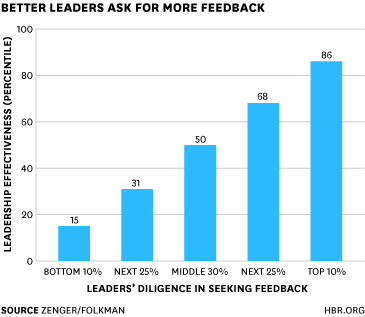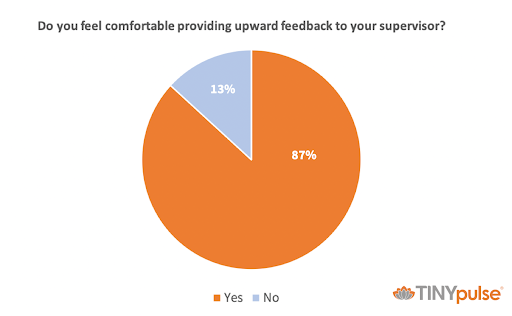How to Ask for Employee Feedback on Management & Leadership

Great leaders don’t just give great feedback. They ask for it too.
Ask yourself the following question: On a scale of one to 10, how would your employees rate your effectiveness as a leader?
Seven? Maybe eight?
No matter how well-thought out your response is, it’s probably wrong. Without actually asking your employees how they feel, there’s no way to know how you truly measure up.
Feedback is invaluable in these situations because it can help you discover and recognize blind spots.
You need it to see if what you are doing is working and identify areas you can improve. This is especially helpful when it comes to advancing your management career.
The value of asking for feedback as a leader
When you ask the right questions, you can improve your leadership skills and grow as a manager.
From management effectiveness to employee engagement, there are several benefits of asking your employees for feedback.
Get the information you need to be a better leader

(Source)
How often do you currently ask your employees for feedback?
Research has shown that the best leaders ask for more feedback more often. In a study of 51,896 executives, researchers found that managers who rank in the top 10% for asking for feedback are rated higher for overall leadership effectiveness.
So get comfortable asking for feedback. It will help you grow individually as a manager and collectively as a leadership team.
Increase your awareness as a manager

As a manager, you have the ability to make or break your team. You’re also one of the biggest influences on how engaged your employees are at work.
According to a Gallup study, managers account for 70% of variances in employee engagement. Your employee engagement levels are important because they directly affect your team’s productivity, profitability, and employee turnover rates.
Employees who feel supported by their managers are often happier at work and more likely to perform at a higher level.
Unfortunately, research has shown that most leadership teams lack self-awareness. TINYpulse found that while 39% of managers strongly agree that management within their organization is transparent, only 22% of employees feel the same way.
Seeking feedback from your employees can bring clarity to opaque situations. Once you see exactly where you stand with your employees, you can start making meaningful improvements that increase employee engagement across your organization.
Build trust with your employees
As a manager, the ability to build relationships with your employees is one of the most important qualities you can have.
A strong manager-employee relationship is built on trust, communication, and transparency. It takes time to establish trust, but seeking feedback (and acting on it) starts a conversation and helps establish credibility.
Don’t worry: Your employees won’t mind. In fact, 87% of employees report they are comfortable giving upward feedback.
The question is whether you have the proper channel or processes employees can use to provide their feedback for managers and see it being acted on.

35 survey questions to evaluate management effectiveness

Surveys are a great way to engage your employees and collect feedback about you as a manager and your entire leadership team.
All of these questions (except the open-ended ones) use a 5-point Likert scale that measures how much each employee agrees with the statement in question.
After reading a statement, your survey respondents can choose from five options:
- Strongly Disagree
- Disagree
- Neither Agree nor Disagree
- Agree
- Strongly Agree
Keeping the scale consistent throughout your survey makes it easier to interpret and analyze data and provide better quality results.
Research-backed employee survey questions
Here are 15 of TINYpulse’s research-backed survey questions that can help you get a better idea of how effective you are as a manager.
- Leadership is generally considered to be a mentor, facilitator, and team player.
- When I do a good job, I receive the proper recognition for it.
- I feel that the work I do is appreciated.
- My superiors make me feel like an important team member.
- Supervisors listen to employees.
- My manager regularly shares relevant information from their manager and senior leaders.
- I like my immediate supervisor.
- The leaders and managers practice what they preach.
- Leaders set goals that are ambitious but realistic.
- I trust my manager to do the right thing.
- The leadership is transparent about the objectives we are trying to meet.
- Leaders have a long-term viewpoint.
- Employees trust management at my company.
- Middle management encourages individual initiative, innovation, freedom, and uniqueness.
- Employees feel empowered to make decisions on their own.
Questions Google uses to get feedback on leadership
Tech giant Google is often cited as a top place to work. Here are 10 questions Google asks its employees about management that you can use on your surveys.
- My manager considers the complaints of employees.
- My manager gives me actionable feedback that helps me improve my performance.
- My manager does not micromanage (i.e., get involved in details that should be handled at other levels).
- My manager shows consideration for me as a person.
- The actions of my manager show that they value the perspective I bring to the team, even if it is different from their own.
- My manager regularly shares relevant information from their manager and senior leaders.
- My manager has the technical expertise (e.g., coding in Tech, selling in Global Business, accounting in Finance) required to effectively manage me.
- I am satisfied with my manager’s overall performance as a manager.
- My manager keeps the team focused on our priority results/deliverables.
- My manager has had a meaningful discussion with me about career development in the past six months.
Open-ended employee survey questions about their direct supervisor
On surveys, open-ended questions can be difficult to analyze. But they can provide you with large-scale insight you wouldn’t be able to otherwise get. Consider using one or two of these open-ended employee survey questions.
- What three words or phrases best describe your manager?
- What is one thing your manager does very well?
- What is one thing you wish your manager would do more of?
- What is one thing you wish your manager would do less of?
- How does your manager recognize you for a job well done?
- What is something you would be afraid to tell your supervisor in person about their performance?
- What does your manager do that makes your job easier?
- What does your manager do that makes your job more difficult?
- What could your manager do to better support your professional growth?
- How have you developed since you began working for your manager?
 Use short, powerful surveys to collect your feedback about management
Use short, powerful surveys to collect your feedback about management

Once you know what questions you want to ask, you’ll need to figure out how you’re going to ask. The best way to do this is to use short, regular surveys instead of asking all of your questions on one big survey.
Receive higher-quality, real-time feedback with shorter surveys
Research has shown that more than 40% of employees’ happiness scores increase within just three months of pulse surveys being introduced at an organization.
These shorter, anonymous surveys provide higher-quality real-time feedback that you can act on immediately. This will keep you ahead of the curve, keep your employees engaged, and increase transparency.
Survey more frequently to get better long-term data
By asking questions more frequently, you’ll be able to collect more insightful longitudinal data. After the first survey, you can follow up with a later survey to get your employees’ takes on what is working well and what’s improving.
This ensures you’re always on the right track. It also allows you to compare your benchmarks each month instead of each year so you can make more data-driven decisions.
Narrow your focus to see noticeable improvements
A common challenge with annual surveys is there are so many different themes and questions. This makes it difficult to prioritize improvements.
When you have shorter, more frequent surveys, it is easier to focus on one issue at a time. Collecting real-time data also ensures the information is still relevant and not outdated.
Being able to narrow your focus makes it easier to improve your performance. These improvements will not only help your team, they can also lead to a more favorable performance review for you.
By listening to your employees and acting on the feedback you receive, you’ll be a more effective manager. You’ll also build trust with your employees and strengthen your professional relationships.
Create a survey action plan to be a better leader

Once your survey results are in, you’ll be ready to create your personal survey action plan. Your action plan doesn’t have to be long. But it should be well-thought out and structured so that you can make effective improvements.
There are three basic steps of creating a survey action plan:
- Digest the management feedback you’ve received
- Develop your leadership improvement plan
- Communicate with your employees
Step 1: Digest the management feedback you’ve received

The first step of creating a survey action plan is to digest and analyze the feedback you’ve received. Remember, your employees are providing feedback based on their own perceptions and past experiences. Try to view all feedback in a positive light.
You’ll want to have thick skin when it comes to feedback. Whether it’s about you personally as a manager or your leadership team as a whole, you asked for it and you got it. Survey responses are often a mixture of good, bad, and ugly.
If something doesn’t make sense or isn’t clear, get curious. With TINYpulse anonymous private messages, you can engage in a two-way conversation with any survey participant.
This can help you better understand the context behind their responses. It also gives you the opportunity to brainstorm potential solutions with your employees without compromising anonymity.
Step 2: Develop your leadership improvement plan

To make meaningful improvements, it’s important to create a structured action plan. Start by prioritizing what you want to work on. Try to focus on an area that will provide the most benefits for the least amount of work.
Once you know what you want to focus on improving as a leader, brainstorm and document:
- The steps you need to take to make the improvement,
- The resources you will need to make it happen,
- A timeframe for accomplishing each step, and
- A date to review and reflect on your progress.
Your action plan should be a living document. If something isn’t working as expected, it’s okay to come back, reassess, and update accordingly.
Step 3: Communicate with your employees

After you’ve asked for feedback and developed your action plan, following up is crucial. There’s no surer way to lose employee trust than asking for their opinions then doing nothing with them. It defeats the entire purpose.
Let your employees know what you are doing as a leader to act on the feedback received. Consider what communications vehicles work best in your organization—e.g., town halls, e-blasts, employee newsletters, intranet, or all of the above—and get the word out.
Another “must do” to increase transparency: Address significant feedback that is not going to be considered or implemented at this time. Let your team know why. You have very limited time to "tell your side” of why an issue or suggestion is not moving forward. Be sure to take it.
Final Thoughts

A large part of being a great manager is being willing to be vulnerable and listen to (and act on) feedback.
Rather than waiting for your employees to come to you, reach out and seek feedback proactively. It not only makes you a more effective manager but it also builds trust with employees and helps you develop a stronger professional relationship.
Getting the right feedback is all about asking the right questions the right way at the right time.
Shorter, more frequent surveys will give you higher-quality data to work with. With TINYpulse, you not only have the ability to check in regularly with your employees, you can also follow up anonymously via private messages to get clarity on specific responses and brainstorm potential solutions.
Discover how you can be an even better manager with TINYpulse.
Share this
You May Also Like
These Related Stories

How Can Managers Use Survey Data to Improve Their Teams




.png?width=534&height=632&name=blog%20ad%20(1).png)
